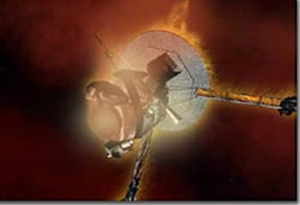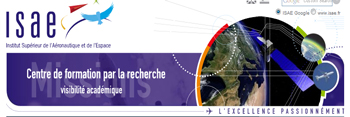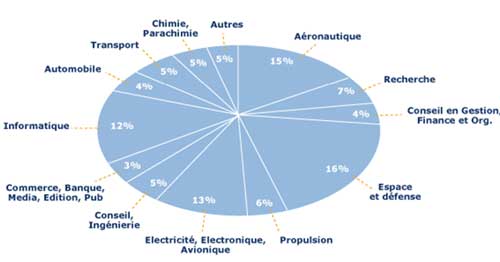This is the second posting in our new Outlook section, which will include regular participations from the upcoming generations. We start with an article by a student from the Toulouse-based Aeronautics and Space Institute (ISAE) – who is also part of our SLDinfo research team -, which gives a first assessment of the general mood and aspirations of the future engineers on the basis of an informal polling of French and Erasmus international students.
***
The French Student Outlook For the Future: “Two Feet Anchored on Earth”
By Amélie Spire
**@*****fo.com
French Aeronautics Engineering Training: a “Cultural Exception” Threatened to Vanish?
There is no specific type of aeronautics engineers in France. This expression refers to numerous profiles: design engineer, production engineer, etc… Since one has to combine different abilities (e.g. electronics, optics, aerodynamics…) in order to make a plane fly, students in the field of aeronautics enjoy a wide range of possibilities when it comes to choosing a specialization. When graduation comes, students can, in spite of their scientific and technical specialization, also hold a commercial position, such as business engineer. Whether working for an industrial company or in services, in a plant or in a research department, they will be required to be able to integrate multicultural and multidisciplinary teams.
French students tend generally to get their early training in engineering schools specialized in aeronautics (ENAC, ESMA, ISAE, ESTACA or Supmeca in France), which all select their candidates via a competitive process. Students coming from other schools, but who have acquired experience in aeronautics companies can also be qualified as engineer in aeronautics. Concretely, the required length of studies is about five years and the average starting monthly income is about 2.700 Euros (about 3.700 US Dollars).
Quite a bit of disparities do actually exist between French and foreign engineers: while in France, “engineering” tends to be assimilated to social status and a good income, intellectual merit seems to be more valued abroad. The French model is in fact often perceived as a complex “cultural exception” and considered by some as doomed to disappear. The drawback of the French system is that it tends to stigmatize engineers as an elitist cast, which only top-level students can join, and not only students passionate by aeronautics. As a result, many French engineering students do not necessarily fit in and 60% of them turn to other careers, such as business, bank, management or else.
Credit: http://www.supaero.org/
Mild Enthusiasm among French Students in Aeronautics and Space
Aeronautics and space have always inspired the wildest dreams: without wings, man keeps looking for ways ahead and is attracted by the sky. Though the economic crisis strongly hits the sector, aeronautics and space industries continue to hire. In 2008, 12.000 people were hired, but the level of overall job creation in the sector declined in 2009. Commercial air transport remains the most hit by the crisis: due to the decreasing number of passengers and increasing of oil prices, experts expect a 6.4 billion Euro loss in 2009, following a 7.4 billion Euro loss in 2008.
(1) Aeronautics: “A Cloudy Sky”
Although young French aeronautics engineers in the making are aware of the current difficult economic and environmental conditions, as well as of a growing international competition, they remain relatively enthusiastic: they appreciate the fact that, attracting a cutting-edge technology, the field has a profound impact on other scientific sectors. They are indeed ready to face up to the challenges, as they are conscious of the economic weight that the aeronautics field embodies.
-
As far as the military aeronautics sector is concerned, many students are betting on UAVs (unmanned airborne vehicles) and believe that the F-35 could be the very last manned fighter aircraft. Except for anti- guerilla air assets, they display some skepticism about new possibilities.
-
Regarding commercial aeronautics, the same students are aware of the competition between the major international aeronautics players: while demand keeps increasing (about 25 000 planes are to be ordered during the next twenty years), the American constructor Boeing and the European one Airbus must cope with the emergence of new competitors, who are decided to get their share in this billion dollar market. Indeed even if the European and American powers keep the monopoly in the construction of airliners, Canada and Brazil both aim at the third place at least. The question young students is how can European and American powers remain in the race while budgets are decreasing?
A cloudy sky, not only in regards to the economy, but also as far as environmental and fuel challenges are concerned. Lack of energy, the search for new green fuels and pollution control are among the issues engineers need to consider when researching. As people tend to travel farther and more frequently, a key question is in many students’ mind: what kind of new green technologies can we develop in order to manage these flows?
(2) Space: A Crowdy Sky
The space industry is facing a strong competition from emerging powers, but the European space industry keeps its rank in the world, thanks to the performance and the liability of its systems. Thanks to innovative space programs, the CNES (Centre National des Etudes Spatiales) contributes to enhance such competitiveness.
With the development of communication and Earth watching satellites, the Ariane 5 launcher (and soon Ariane 6), the European project Galileo, the upcoming replacement of Hubble, and the NASA prospect to go back on the Moon in ten years or so, space represents a major stake. In a context of economic crisis, the key issue remains however the question of funding. European students stress the fact that it is necessary to invest in a new launcher program, in order to keep a leading position in satellite launch. As a matter of fact, Ariane 5 has reached its performance limits as far as payload is concerned.

In addition, the risks associated with funding shortage raise other questions, such as: how can private companies join the market without an excessive privatization of space? Where can we find sufficient funds? The pessimists also warn against space overload (old and unusable satellites, Space waste…), as well as the replacement of aging communication satellites. Research inertia is also listed among the mains worries expressed by the aeronautics and space engineering students, while the traditional debate about the military use of space divides the opinion.
Both Feet on Concrete (Economic) Grounds
Thus, the future remains full of questions for French students who will have to face an evolution of their status. Can-do mentality and a certain polyvalence tend to be engineers’ traditional qualities and a real asset for the future. Furthermore, even if the competition tends to increase today, the world’s lack of engineers in aeronautics offers interesting career prospects for those who are willing to pursue their dreams. Nonetheless, today’s engineers cannot ignore economic realities: technical training is not sufficient, and no one can now afford not to have a basic economic knowledge to fit in with the outside world (the exemple of the Concorde speaks on its own, as it was a technological success, but not such a great economic one, at least on the French side).
Challenges to face, stakes to take on: space and aeronautics trigger enthusiasm and confidence among the generation of engineers to come. Far from being omniscient, they are fully aware that difficulties may lie ahead of their path, but they are willing to cope with the latter as best as they can…
———-
***Posted January 23rd, 2010



